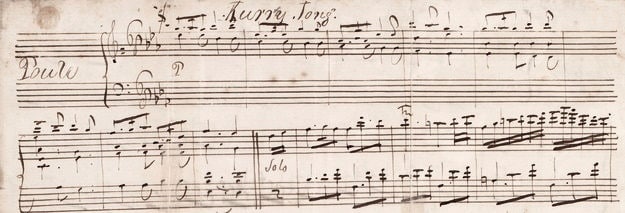THIS PAGE LAST MODIFIED Monday 15 September 2025 7:53

Kurry Jong, quadrille, by William Joseph Cavendish, Sydney-Parramatta, April 1833; from the earliest extant manuscript of a settler Australian musical composition; Castell family papers, State Library of New South Wales
Australharmony
An online resource toward the early history of music in colonial Australia
Dr GRAEME SKINNER (University of Sydney)
SPECIAL CARE NOTICE
Aboriginal and Torres Strait Islander people are respectfully advised that this site and links contain names, images, and voices of dead persons.
ACKNOWLEDGEMENT OF COUNTRY
Australharmony acknowledges and pays respect to the Gadigal people of the Eora Nation, upon whose ancestral lands, and in respectful emulation of their careful stewardship of country and history, that this site has been built and is maintained.
Site directory - see left sidebar
To navigate the site and links use the left sidebar
Pulldown menus for the Biographical register and Chronological checklist
Site history
Graeme Skinner is the author and curator of this online resource on music and musicians in early colonial Australia.
He is an Honorary Associate, Sydney Conservatorium of Music, University of Sydney.
Australharmony was first launched online in January 2012, and regularly updated thereafter.
Since 1 July 2014, it is published online at PARADISEC, Sydney Conservatorium of Music, University of Sydney.
For three years from April 2021 until March 2024, the ongoing development of Australharmony was partly supported by the Australian Research Council through the Discovery Project, Hearing the Music of Early NSW, 1788-1860.
Australharmony is regularly updated as an open source report on ongoing research, work-in-progress toward the history of music, musicians, and audiences - Indigenous, settler, and visitor - in early colonial Australia.
It contains records of music from the earliest documented contacts between Indigenous Australians and outsiders, especially between British colonisation in 1788 and the 1860s, but also continues to document the later careers of key musicians, and covers later documentation of early colonial music and musicians in late 19th, 20th, and early 21st century sources.
By providing links to a mass of online content, Australharmony is also a virtual anthology of Australian colonial music and documentation.
The alphabetical Biographical register currently includes documentary biographical entries on close to 3,000 professional and amateur musicians first active between 1788 and the 1860s.
Why "Australharmony"?
The colonist, judge, natural philosopher, and wit Barron Field was the first person to go into print attaching the epithet "Australian" to a piece of music.
Click here for his 1823 transcription of an Australian national melody.
Barron Field also believed he was the first Australian poet to issue a printed collection of his own work, First fruits of Australian poetry, the first edition of which appeared in Sydney in 1819.
The collection is best remembered now for its second poem, The kangaroo.
But also of interest, Field clearly intended the epigraph on his titlepage as a challenge to posterity:
I first adventure. Follow me who list;
And be the second Austral Harmonist.
Australharmony in TROVE
Under the TROVE username Australharmony, Graeme also curates a large and growing set of tagged resources inside TROVE.
Clicking here or selecting the Australian colonial music tag inside Trove gives instant access to over a curated selection of over 22,000 items, including:
A virtual anthology of over 2,500 Australian colonial musical compositions, arrangements, and editions under Music, audio & video
Almost 19,000 relevant newspaper articles and advertisements under Newspapers and gazettes
Around 800 books and 300 journal articles on Australian colonial music under Books & libraries
Grouped resources on over 350 musicians and composers under People & organisations
Almost 600 images of colonial composers, musicians, and instruments under Images, maps & artefacts
You can then use Trove's powerful search functions to locate materials on specific subjects within the Australian colonial music virtual archive.
Shareable links to TROVE tagged items on specific individual musical personnel, groups, venues, and many musical works, also appear in relevant entries inside this site.
Copyright
This is a not-for-profit non-commercial site, which contains transcriptions of much printed material and many digitised images of originals that are out of copyright.
As a matter of course, Australharmony acknowledges the source of the material or image by providing not only a reference or citation in the usual way, but, wherever possible, also provides a live URL to the digitised web original or originals sourced, whether freely accessible, or behind paywalls.
Fair use excerpts from copyright materials are also occasionally reproduced here; and otherwise, where necessary, explicit permissions have been sought.
Australharmony claims copyright over the editorially curated content and compilation. No one, under any circumstances, may reproduce for commercial or academic republication the whole of any component part of this site.
However, this is an open resoursce, and subject to fair use, Australharmony actively encourages users to constructively reuse material from these pages in their own original research and writing. Nevertheless, it is the user's responsibility to cite Australharmony as a source, in exactly the same way as a printed published work.
Australharmony in Pandora . . .
Some users will come first to Australharmony via search results in Trove's Archived websites tab. What you are seeing there are results not from the live site, but from the most recently harvested version in the NLA's Pandora achive. Australharmony is harvested by Pandora periodically. Its Pandora address is:
http://pandora.nla.gov.au/tep/143528
And click here to view the version harvested by Pandora:
Australharmony as on 27 October 2024
© Graeme Skinner 2014 - 2025